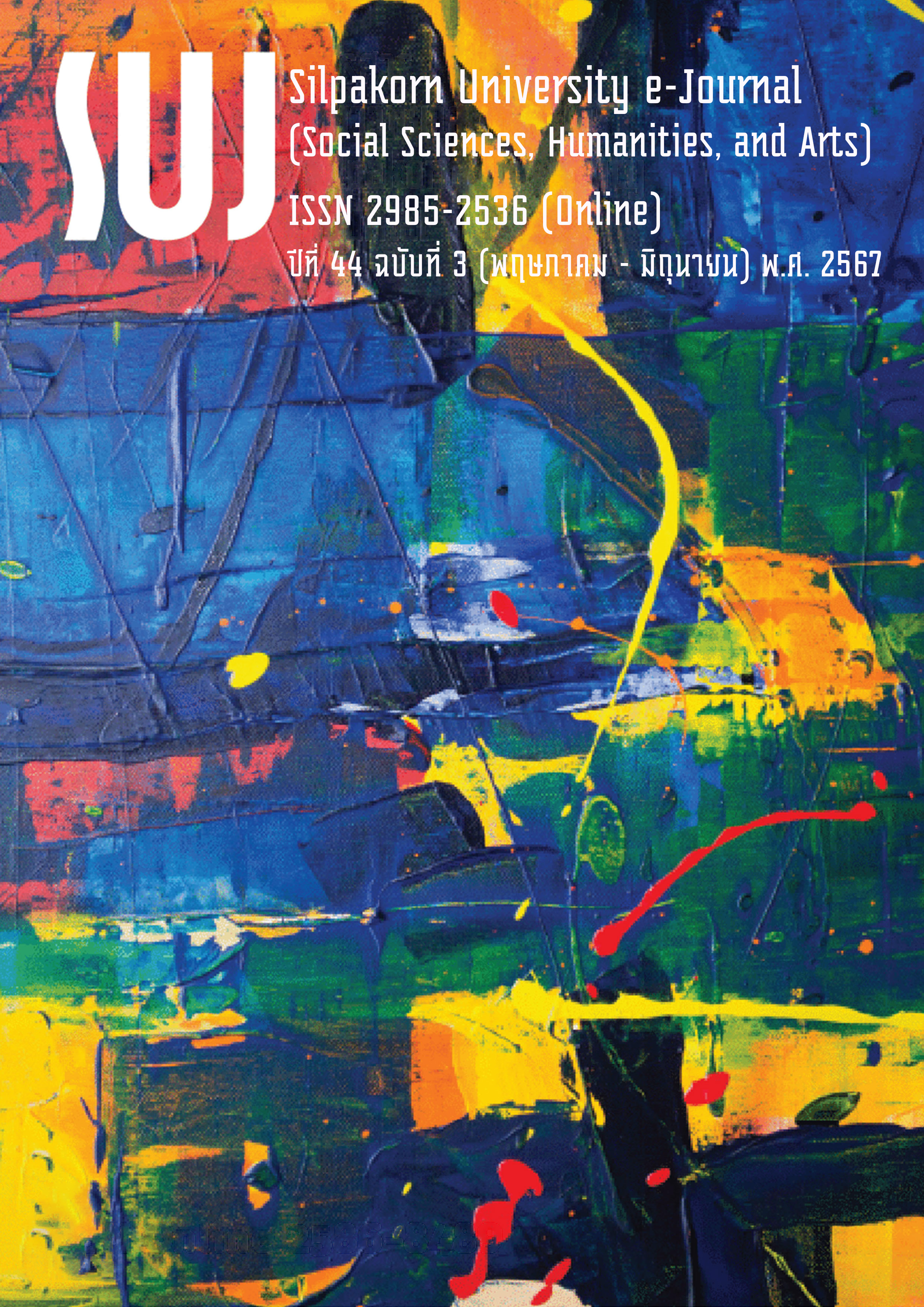ผลการใช้รูปแบบการจัดการเรียนรู้ด้วยกิจกรรมเป็นฐานร่วมกับเทคโนโลยี เพื่อส่งเสริมความเป็นนวัตกรและผลงานสร้างสรรค์สำหรับนักเรียน (The effect of using an activity-based learning model combined with technology to promote innovation and creative work for students)
Main Article Content
Abstract
การวิจัยครั้งนี้มีวัตถุประสงค์เพื่อประเมินประสิทธิผลรูปแบบการจัดการเรียนรู้ด้วยกิจกรรมเป็นฐานร่วมกับเทคโนโลยี เพื่อส่งเสริมความเป็นนวัตกรและผลงานสร้างสรรค์สำหรับนักเรียนในระดับชั้นประถมศึกษาและมัธยมศึกษา ได้แก่ 1) ความเป็นนวัตกร 2) ผลงานสร้างสรรค์ และ 3) ความคิดเห็นของนักเรียนที่มีต่อการจัดการเรียนรู้ด้วยกิจกรรมเป็นฐานร่วมกับเทคโนโลยี โดยใช้กระบวนการวิจัยและพัฒนา กลุ่มเป้าหมาย ได้แก่ นักเรียนโรงเรียนสาธิต มหาวิทยาลัยศิลปากร ทั้งระดับประถมศึกษาและมัธยมศึกษา ในภาคการศึกษาที่ 2 ปีการศึกษา 2563 จำนวน 89 คน เครื่องมือที่ใช้ในการวิจัย ได้แก่ 1) รูปแบบการจัดการเรียนรู้ด้วยกิจกรรมเป็นฐานร่วมกับเทคโนโลยีฯ 2) แผนการจัดการเรียนรู้ตามรูปแบบฯ 3) แบบประเมินความเป็นนวัตกรของนักเรียน 4) แบบประเมินผลงานสร้างสรรค์ของนักเรียน และ 5) แบบสอบถามความคิดเห็นของนักเรียน สถิติที่ใช้ในการวิจัย ได้แก่ ร้อยละ ค่าเฉลี่ย ค่าส่วนเบี่ยงเบนมาตรฐาน และวิเคราะห์เนื้อหา ผลการวิจัย พบว่า 1) ความเป็นนวัตกรของนักเรียนส่วนใหญ่อยู่ในระดับดีมาก โดยมีคะแนนระหว่าง 18-20 คะแนน จากคะแนนเต็ม 20 คะแนน จำนวน 54 คน คิดเป็นร้อยละ 60.67 2) ผลงานสร้างสรรค์ของนักเรียนในภาพรวมอยู่ในระดับดีมาก และ 3) ความคิดเห็นของนักเรียนที่มีต่อการจัดการเรียนรู้ด้วยกิจกรรมเป็นฐานร่วมกับเทคโนโลยีของครู พบว่านักเรียนทุกระดับชั้นทั้งระดับประถมศึกษา ระดับมัธยมศึกษาตอนต้น และระดับมัธยมศึกษาตอนปลาย มีความคิดเห็นว่าเหมาะสมมาก ผลการวิจัยนี้จะเป็นแนวทางให้โรงเรียนได้จัดกิจกรรมการเรียนรู้ที่โรงเรียนต้องการพัฒนาคุณลักษณะของนักเรียนให้มีความเป็นนวัตกรและสร้างสรรค์ผลงานโดยการใช้เทคโนโลยี
This research aims to evaluate the effectiveness of an activity-based learning (ABL) model integrated with technology to promote innovation and creative work among elementary and high school students. The research focuses on three key areas: 1) nurtured innovators, 2) creative work, and 3) student perceptions of ABL with technology. The research and development process was used. The target groups consisted of 89 students from both elementary and secondary levels at Silpakorn University Demonstration School during the second semester of the 2020 academic year. The research tools were: 1) the ABL model integrated with technology, 2) lesson plans based on this model, 3) an innovation assessment form for students, 4) a creative work assessment form for students, and 5) a student opinion questionnaire. The statistics used in the research included percentages, mean, standard deviation, and content analysis. The research findings were as follows: 1) The majority of students scored very high on the innovation assessment, with 54 students (60.67%) scoring between 18-20 out of a possible 20 points. 2) Overall, the students’ creative work was rated as very good. 3) Students’ opinions on the ABL model combined with technology showed that students across all levels—elementary, middle, and high school—found it to be highly appropriate. These research findings provide a guideline for schools to design learning activities aimed at developing students’ innovative characteristics and creative work through the use of technology.
Downloads
Article Details

This work is licensed under a Creative Commons Attribution-NonCommercial-NoDerivatives 4.0 International License.
References
Dewey, J. (1938). Experience and Education. NY: The Macmillan Company.
Office of the Education Council, Ministry of Education. (2018). Development of Mechanisms Driving the Teacher Production and Development System High Performance for Thailand 4.0 (การพัฒนากลไกขับเคลื่อนระบบการผลิตและพัฒนาครูสมรรถนะสูงสำหรับประเทศไทย 4.0). Bangkok: Phrikwan Graphic.
Patphol, Marut. (2018). Assessment of Curriculum for Learning and Development (การประเมินหลักสูตรเพื่อการเรียนรู้และพัฒนา) (4th ed.). Bangkok: Charansanitwong Printing.
Sithsungnoen, Chanasith, & Chanintharaphum, Akasit. (2021). The development of learning activities using activity-based learning to enhance creative learning management ability of pre-service teachers. In Proceeding of the 3rd International Conference on Multidisciplinary and Current Educational Research (ICMCER-2021), (pp. 786-793). Ayuttaya: Mahachulalongkornrajavidyalaya University.
Sithsungnoen, Chanasith, Saphuksri, Suwimon, Aonpa, Saranjit, Chatiyanon, Boonrod, Chanintarapum, Akesit, Poomraruen, Akkachai, & Sooksena, Seksan. (2022). The development of activity based learning management model integrated with technology to promote students’ innovativeness and creative products (การพัฒนารูปแบบการจัดการเรียนรู้ด้วยกิจกรรมเป็นฐานร่วมกับเทคโนโลยีเพื่อส่งเสริมความเป็นนวัตกรและผลงานสร้างสรรค์สำหรับนักเรียน). Journal of Humanities and Social Sciences Review, 24(2): 146-159.
Stößlein, M. (2009). Activity-based Learning Experiences in Quantitative Research Methodology for (Time-Constrained) Young Scholars - Course Design and Effectiveness. Paper presented at the 20th Annual Conference of the Production and Operations Management Society. Orlando, Florida. May 1-4.
Stubbs, S. (2008). Inclusive Education: Where there are Few Resources. [Online]. Retrieved September 10, 2021 from https://www.eenet.org.uk/resources/docs/IE%20few%20resources%202008.pdf
Trilling, B., & Fadel, C. (2009). 21st Century Skills: Learning for Life in Our Times. San Francisco, CA: Jossey-Bass.
Wongyai, Wichai, & Patphol, Marut. (2019). Development of Creative Skills for Innovation (การพัฒนาทักษะสร้างสรรค์นวัตกรรม). Bangkok: Innovative Leaders Center in Curriculum & Learning (LCCL).


